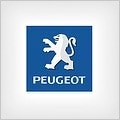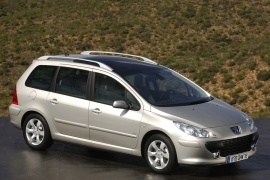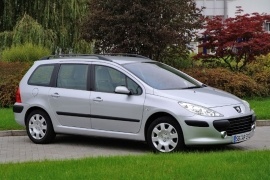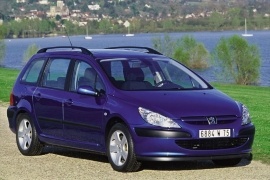
PEUGEOT 307 SW
Generations Timeline, Specs and Pictures

The European emission standards raised the bar to the Euro 5 level in 2005, and all carmakers had to adapt, leading to an avalanche of facelifts and new models.
Since the 307 was already four years old, Peugeot decided to introduce a mid-life cycle impulse to its compact-segment contender. As a result, the French carmaker upgraded the vehicle in all the areas and became a stronger contender for Volkswagen Golf. However, while the five-door version remained the top-seller, the SW kept its crown for the largest trunk among its stablemates.
From the outside, the car featured a front fascia that resembled its bigger brother, the 407 sedan. It showed clear headlights and a smiling grille on the apron, under the black rubber bumper protection. For a cleaner look, Peugeot replaced the previous black, unpainted side stripes with body-colored ones. It applied the same treatment on the rear bumper, where the corner-mounted protections were no longer black.
Inside, there were slight changes when compared with its non-facelifted version. The door handles featured chromed surroundings instead of the simple, black ones. Peugeot also improved the material’s quality and worked on the fit and finish department. Like its predecessor, the 2005 307 SW was available with an option for a panoramic glass roof. There were no improvements in the trunk department, which provided 504 liters (17.8 cu-ft) with the rear seats up, and up to 1,805 liters (63.7 cu-ft) with the second row folded down.
Under the hood, Peugeot improved the 307’s engine lineup. While it dropped the former 1.4-liter turbo-diesel, it left only three oil-burners in the offer. The most potent version still provided 143 hp.

Peugeot introduced the 307 on the market in 2001, as its competitor in the compact-segment, and proved successful.
Later on, in 2005, it refreshed the entire lineup.
While most of its competitors already refreshed their compact vehicles for the new Euro 4 pollution norms, Peugeot waited. It already fulfilled the mandatory requirements, and all it had to do was to introduce a refreshed version later than anyone else. Suddenly, it was the newest car on the market. It was a wise strategy that worked well. Moreover, its station-wagon version was available with a panoramic glass roof. It was something that neither Ford, Volkswagen, or Opel featured on their options list.
The new 307 design featured a broad black grille at the front and clear-lens headlights. For the vehicles fitted with fog-lights, the French carmaker introduced chromed rings around them. The grille in the hood was deleted and featured a raked-forward nose design that resembled a race-car. Still, it didn’t replace the door-mirrors, which were mounted closer to the driver than on other competitors from the compact-segment. The bumper featured a deep cut in the rear, so the wagon was easier to load and unload.
Peugeot insisted on making the car looks more stylish than its competitors, introducing wood-trims on the center stack and door panels, even though it wasn’t a premium carmaker. The 307 offered a digital HVAC control system on the options list.
Under the hood, Peugeot installed a wide choice of diesel and gasoline engines ranged between 90 hp and 143 hp. Most engine options were available with an automatic gearbox.

Peugeot introduced the 307 lineup in 2001 as a replacement for its aged 306 hatchback and added the station-wagon version, named SW, in 2002.
Since most European brands had a compact station wagon in their offer, Peugeot had to do something slightly different to prove its experience in that segment. The carmaker named its wagon SW (Sport-Wagon), and offered it a panoramic glass-roof to enhance the onboard experience.
The 307 featured the French carmaker’s new design language, which showed feline-inspired shape for the headlights. While it couldn’t fit a lion nose in the grille, it made it with one horizontal slat and stuck the company badge in the middle. In the apron, the carmaker installed a smiling-shaped grille and a black lip at the bottom. The rear doors featured a straight-up frame for the window. In the back, the vertical tailgate was extended downward and cut a big chunk of the bumper, thus allowing a lower load area.
Inside, the carmaker installed comfortable seats at the front and a 60/40 split-folding bench in the back. With all seats in place, the 307 SW offered 504 liters (17.8 cu-ft), while with the bench folded, it provided up to 1539 liters (54.3 cu-ft). Thanks to the tall greenhouse and straight roofline, the rear passengers had more headroom in the SW than in the regular hatchback version.
Under the hood, Peugeot offered a wide choice of gasoline and turbo-diesel engines. Most versions were paired with a five-speed manual gearbox, and, for selected engines, a four-speed automatic was on the options list.

Peugeot expanded the 307 lineup with the SW model in 2002, continuing a long line of station wagons in the French’s carmaker history.
Since most European brands had a compact station wagon in their offer, Peugeot had to do something slightly different to prove its experience in that segment. First of all, the carmaker named its wagon SW, which was also used as Sport-Wagon, and offered it with a panoramic glass-roof to enhance the onboard experience.
The 307 featured the French carmaker’s new design language, which showed feline-inspired shape for the headlights. While it couldn’t fit a lion nose in the grille, it made it with one horizontal slat and stuck the company badge in the middle. In the apron, the carmaker installed a smiling-shaped grille and a black lip at the bottom. On its sides, the car looked similar to its hatchback version up to the roof, which was available with a set of roof rails. The rear doors featured a straight-up frame for the window. In the back, the vertical tailgate was extended downward and cut a big chunk of the bumper, thus allowing a lower load area.
Inside, the carmaker installed comfortable seats at the front and a 60/40 split-folding bench in the back. With all seats in place, the 307 SW offered 504 liters (17.8 cu-ft), while with the bench folded, it provided up to 1539 liters (54.3 cu-ft). Thanks to the tall greenhouse and straight roofline, the rear passengers had more headroom in the SW than in the regular hatchback version.
Under the hood, Peugeot offered a wide choice of gasoline and turbo-diesel engines. Most versions were paired with a five-speed manual gearbox, and, for selected engines, a four-speed automatic was on the options list.























































